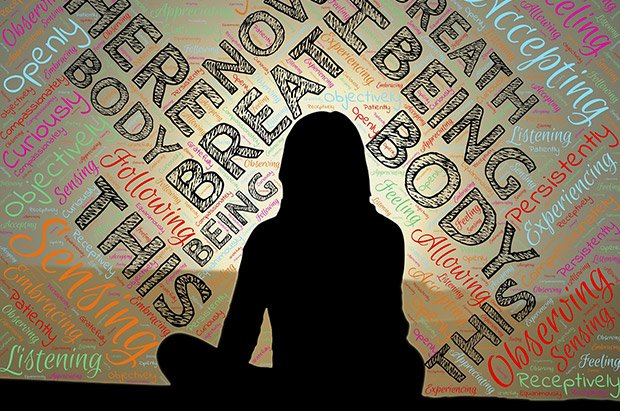
Self-hypnosis is simply the ability to focus your attention on a specific goal whilst in a deeply relaxed state of mind and body.
When you use the following guide and you go into a self-induced trance state, you can choose to focus your energy on a specific goal, or simply experience the benefit of hypnosis by stilling your mind and going into a deep state of mental and physical relaxation.
This guide to self-hypnosis has a wide variety of therapeutic applications. In particular, it is very effective in the alleviation of stress and tension, in helping to regulate sleeping patterns and for focusing on goals.
Creating the right atmosphere
To practise self-hypnosis you need to go to a quiet room where you will not be disturbed, preferably a bedroom with no telephone. Dim the lights or turn them off. You may choose to light a candle or burn relaxing aromatherapy oils, such as lavender or chamomile.
Use anything that helps you to create a relaxing atmosphere. Once you become skilled at self-hypnosis you can use it in busy places where there are noises and distractions. With practice you will find it easy to block out distractions and still be able to focus your mind intently.
Preparing yourself
You can either lie down on a couch or bed or sit upright in a comfortable chair, preferably with a headrest. Make yourself as comfortable as possible and avoid crossing your legs or arms. Make sure your clothing is loose and comfortable and the temperature of the room is neither too hot, nor too cold. Tell yourself silently or out loud that you are going to practise self-hypnosis.
Then tell yourself silently or out loud how long you want to remain in the trance. Fifteen to twenty minutes is fine to begin with. However, after a little practice you may decide to make your self-hypnosis sessions last longer. The key to using self-hypnosis successfully is the ability to focus your mind intently on a single goal even if that goal is just enjoying the experience of hypnosis by creating a deeply relaxing mental and physical state.
You don’t do this by intellectualising or forcing the process, as the aim of self-hypnosis is to let go of any conscious thoughts. Think of a push and pull, yin (female) and yang (male) energy. Self-hypnosis is very much a yin energy where you let go and allow the feeling of relaxation to gently engulf you and where you also allow your mind to become very still and quiet.

Hypnosis and self-induced hypnosis is usually an evolving state where the depth of trance you experience will fluctuate. Even though conscious thoughts may still creep in at various times all you need to do is let them go, clear your mind and drift deeper again. During self-hypnosis it is likely you will go through various levels of relaxation in a similar way to the sleep stages you go through at night.
When you go to sleep at night you go through five stages of sleep that get progressively deeper and last for about 90 minutes. You then repeat that whole 5-stage process over and over again through the night.
Hypnosis is a similar journey; so don’t think it is not working if, after a while, you feel you are not in a deep enough trance state as it may be that you have entered a lighter trance stage and self analysis will only lighten the trance even more.
The key is to remain focused on your goal in spite of intellectual distractions or mental chatter; by doing this you will naturally drift deeper again and the thing you are focusing on will become stronger. In summary, the state you are aiming to create is one of strong focus where you are deeply relaxed and your mind is calm and not actually ‘thinking’.
You must achieve this deep mental focus and physical relaxation through your feelings. This is similar to the experience of having a pleasant dream or daydream where you are guiding yourself in the dream without thinking about it. Using your inner feelings is an important part of self-hypnosis, especially when you focus on specific goals such as personal success or weight loss, for example.
The breathing technique
Breathing techniques are a very good way to begin self-hypnosis because by drawing more oxygen into your body and up to your brain, this will help to you release tension and relax fairly quickly.
- To begin, close your eyes and breathe very slowly and deeply in through your nose and out through your mouth. Continue building a very slow and very deep rhythmical breathing pattern.
- Visualise and feel the new breath of air travelling into your airways and swirling around your lungs and clearing out any stale air with every slow out-breath.
- Make sure you breathe from your diaphragm (lower chest area) and not from the upper chest. Watch what happens to your body as you breathe. If you are breathing properly, your stomach will go out as you breathe in and will go in as you breathe out. If you are unused to diaphragmatic breathing, this may take a little practice.
- After a short while you can take this a step further if you wish. At the top of your breath, hold it for three seconds and then count to five on every out breath. As you breathe out, imagine you are breathing away any nervous tension left in your body.
- Really feel any mental or physical stress disappear as you slowly breathe out. You can also say the word relax on every out-breath, if you wish.
Use the parts of this technique that work the best for you although breathing from your diaphragm is something you should always do. Continue this breathing pattern ten or more times, or for as long as it takes for you to feel pleasantly relaxed.
Clearing your mind
After a little practice you may want to use this clearing your mind technique and your breathing technique at the same time.
This will help you to avoid intellectualising the breathing technique and can help you to go into a pleasant light trance fairly quickly. Don’t underestimate the simplistic power of this mind clearing section, as even if you did this part on its own it can be a very good discipline for destressing and energising your mind.
Use any one of the visualisations below that resonate with you. Allow your mind to go completely blank.
Don’t worry if you still get unwanted thoughts drifting into your mind; tell yourself not to fight them, as they will soon drift away again. Every time you get an unwanted thought, imagine a large red stop sign. As soon as you see the red stop sign, imagine the thought disappearing and your mind becoming clear.

Another thought-clearing technique is to imagine a large computer screen full of data that becomes blank by hitting a keypad. Imagine that by pressing a keypad you can clear your mind. Another method is to imagine you are looking up at the sky on a pleasant summer’s day.
You notice a few small clouds that drift across the sky and then fade away. Eventually all of the clouds have drifted away and the sky is clear. Imagine your conscious thoughts are like clouds that fade away. Use whatever method works for you but spend time getting this part right as calming your mind is the key to achieving deeper levels of hypnosis.
Relaxing your body
Now you can place your whole focus on relaxing your body. Imagine every muscle completely relaxing, from the top of your head to the tips of your toes. Imagine your eyelids have become heavy and tired and any tension in your forehead is disappearing. All the muscles there are becoming loose and relaxed. Start at the top and systematically work your way down to your toes.
Take your time to do this thoroughly. Self-hypnosis should be a journey you enjoy from start to finish with a feeling that you have all the time in the world. Continue this pattern and imagine all the muscles relaxing in your jaw, neck, shoulders, back, arms and legs. Imagine the relaxation spreading down through your body, letting go of any tightness or tension in the muscles.
You can visualise the muscles relaxing and spend extra time relaxing any part of your body that holds more tension. Allow the outside world to fade into the background and continue your journey into your inner world.
Throughout the whole process you should re-focus on clearing your mind at intervals just by breathing away any unwanted thoughts. Spend a few minutes clearing your mind after each section, then move on. Take your time when you do this and enjoy the process of letting go.
Deepening the trance state
By now you will already be in a light trance state. A good technique to guide yourself deeper into trance is to count down silently and mentally from ten to one and imagine you are drifting deeper with every number. Feel every muscle in your body relax more and more with each descending number. Leave about five seconds between each number or, if you prefer, you can count each number down on every second or third outbreath.
Do whatever feels right but take your time at this point and really let go and allow yourself to drift deeper and deeper inside. Feel as though you are journeying into your inner worlds by floating down deeper and deeper with each number. To enhance this you can also use visualisation techniques. For example, imagine you are travelling down ten flights in an elevator; or stepping down ten steps into a beautiful garden.
Count down with each flight or step, going deeper with each number. Use whatever feels right for you. Don’t get hung up on the feeling that you are not deep enough in trance or that nothing is happening. Being in a trance is often very subtle.
The more you practise the better you will get and in time, you will begin to know intuitively when you are in a deeper, more receptive state.
Conversely, do not fear going into a deep trance - self-hypnosis takes you to a powerful part of yourself where you can make lasting, positive changes. It is a popular myth that you lose control under hypnosis, when in fact you are creating a state where you are taking back control. All destructive habits like overeating, smoking, anxiety-related habits and phobias are as a result of losing a degree of control at some point. By using self-hypnosis you will be able to reprogram your mind and regain control of habits that you have been unable to control by conscious thought alone.
Allow yourself to go deep inside your mind and tell yourself you feel safe and secure as you do this. Someone once asked me if they could get stuck in the unconscious state. This cannot possibly happen. You may fall asleep in trance, but you would then wake up in your own time, as you would from a regular sleep state.
Utilising the trance state
When you reach the deeper trance stage you can either relax and drift or you can give yourself some positive suggestions or affirmations, the wording of which must have been decided upon before you start. You can also use powerful imagery (see The Power of Imagery below).

Word your affirmations correctly
Work on only one goal at a time, usually over a number of sessions. For example, don’t work on releasing a fear and losing weight in the same session. You can use a number of affirmations in one session but they all must relate to your one chosen goal at this time. Silently and mentally repeat the affirmations over and over, slowly and positively, using as few words as possible.
Be very direct, as though you are giving yourself commands. Sometimes you can create a rhythm with your breathing saying the affirmation on each out breath, almost like a chant or mantra. When deciding on the suggestions beforehand always state them as if they are a reality and in the present. This is very important, as your unconscious mind believes exactly what it is told.
For example:
Do NOT say: ‘I want to be calm and composed under pressure.’
Do say: ‘I FEEL calm and composed under pressure.’
Do say: ‘I AM always calm and composed under pressure.’
You must make any suggestion completely unambiguous and Always Accentuate The Positive. When you repeat these affirmations, say them with conviction and believe they are a reality. The stronger the feelings you create, the more effective the affirmations will be.
So really put your heart and soul into embracing these positive new affirmations so they become anchored in your unconscious mind. I tend to use the words ‘I love to…’ to begin many of my affirmations as love is a powerful word and I have found this type of affirmation seems to have a powerful impact.
It is important to really feel the affirmations as you repeat them, draw them inside you and let every cell in your mind and body resonate with positive feeling and emotion.
Imagine every part of you is repeating the affirmations with complete conviction and total belief in what you are stating. Even if it feels a bit odd at first, stay with it, as your unconscious mind believes exactly what it is told. You are creating new positive beliefs that will be accepted by your unconscious exactly as they are, without any analysis. That is why taking time and care to list your affirmations correctly is very important.
The power of imagery
Visualisation works so effectively because of a key ingredient in mind programming – the human mind doesn’t distinguish between what is real and what is imagined. So, when you create a future visualisation, your mind will accept it as a reality and you will respond to that programming.
I liken this process to programming a computer; what you put in will come back out. The human mind is exactly like that. By programming your computer with positive beliefs or imagining a future situation or event in a very positive light, you will set yourself up for success.
An example of this is flying, which for most people causes anxiety. For some people the anxiety is debilitating. But when you program your mind to enjoy flying through visualisation and affirmation, that is what you will feel when you next fly for real. When you come to experience the event in reality, your unconscious mind will believe you have been there before, and you will feel composed and in control when you fly.
I once hypnotized a chronically fearful flyer who overcame his fear of flying to such a degree he became a dangerous sports enthusiast revelling in skydiving and bungee jumping! He became chronically fearless! Using visual imagery along with affirmations when in the trance state is a very powerful way of absorbing beliefs into your unconscious mind.
It is important to be creative and make your visualisations colourful and elaborate. When you visualise, use as much detail as possible and use all of your senses to make the visualisation realistic.
When you visualise a future event, run the images in your mind like a short film using as much detail as possible. If you are going for an interview see the shape and size of the room, notice the colours of the walls and carpet, feel your clothes against your skin, notice the fresh smell of the room, the softness as you sit in the chair.
Make the whole picture bright and clear and use as many of your senses as you can; the more vividly you use your imagination the better. Most importantly, always see yourself in a completely positive light, expressing yourself clearly and confidently and feeling very calm and composed under any pressure.
You can use this powerful technique to prepare yourself for so many things, such as an exam, a sporting event, public speaking, or for business and social occasions. I always feel for people when they blow a big opportunity through nerves or anxiety.
Learning these techniques can help absolutely anyone overcome their fears in pressure situations. Needless to say, when you do the opposite and worry about a future event you are programming your mind with fear, which it will respond to at the time of the future event.
I have seen highly capable, intelligent people blow big opportunities because of the anxiety that they created around an event. You often see this on TV talent shows when talented novice singers crumble when they are asked to perform under pressure. I always wish I could help them when I see this because it is really so easy to overcome stage fright.
The very best way to overcome the fear of high-pressure situations is to visualise the future event and create an entirely positive scenario using all of your senses and as much creativity as possible. This way you will set yourself up to succeed by creating a peak performance state at the time when you need it most.
Positive programming is something that most top sports people use, as do many people who are successful in their careers. We are all blessed with an ability to imagine, and when we learn how to harness the power of our imagination we can achieve practically anything.
Bringing yourself back to full consciousness
When you feel it is time to wake up from the trance, all you need to do is slowly and mentally count up from one to ten. Tell yourself you are becoming more awake with each number. When you reach the number ten, your eyes will open and you will be wide awake with a feeling of total well being.
If you practise before going to sleep, you do not need to count up from one to ten. Simply tell yourself before you begin that the trance will turn into a deep, natural sleep from which you will wake up in the morning feeling positive and refreshed.
Key Points
- Creating the right atmosphere.
- Preparing yourself mentally and allowing a set amount of time for self-hypnosis.
- Spending 10 minutes or more on creating a slow rhythmical diaphragmatic breathing technique and clearing your mind.
- Deepening the trance state through visualisation.
- Utilising the trance state by using affirmations and visualisations to focus on a specific goal which must have been decided upon before you begin.
- Bringing yourself out of hypnosis and back to full waking consciousness.
Please note:
When you first practise hypnosis, do not worry if you don’t think much happened or you could not see much in the visualisation. Just the fact that you went somewhere quiet and centred yourself by closing your eyes and relaxing will have benefited you.
You will be surprised at how effective a suggestion can be in even the lightest of trances. The power of the unconscious mind works in a very subtle way.
The most important thing to remember is to enjoy the process and to have faith, because as with all things, the more you practise the better you become!
Best Wishes,
Glenn Harrold
P.S. If you would like some guidance you can try one of my meditations available on YouTube for free:
Useful Resources
Website: www.glennharrold.com
YouTube: www.youtube.com/user/doctorofthemind
Good!
Downvoting a post can decrease pending rewards and make it less visible. Common reasons:
Submit
Solid, clear and powerfully presented!
He even manages to weave in some key aspects of Neuro Linguistic Programming without missing a beat.
You can learn more about self-hypnosis here than from entire books on the subject.
This one is a gem!
Downvoting a post can decrease pending rewards and make it less visible. Common reasons:
Submit